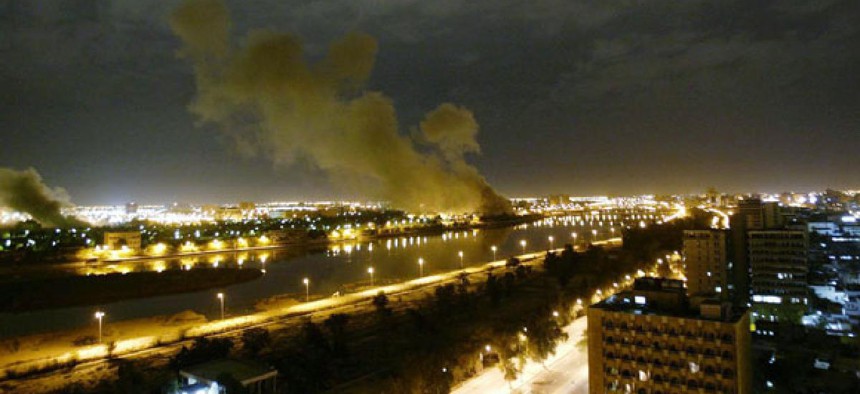The First Days of the Iraq War, as Seen Through Correspondents
It is clear there were no simple answers to the farthest-reaching questions.
Back then, our national fears came color-coded.
It was the week of March 18, 2003, and again the national terror alert system had been upgraded from yellow to orange. Since its inception shortly after 9/11, the national threat meter had been bouncing back and forth between the two colors, often for reasons that often avoided a clear rule. But this time, the upgrade made sense. We had just invaded Iraq.
“The alert system's lack of nuance has some state and local officials questioning its utility,” Siobhan Gorman, a National Journal reporter, wrote on the development. Many would come to make a similar criticism of the Bush administration’s evaluation of the Iraqi threat.
National Journal, like the rest of the media, was trying to make sense of the fog of war. While the press is now criticized for not acting as a strong watchdog during this time (by not thoroughly vetting the claim that Iraq had weapons of mass destruction), journalists were getting a sense of how this invasion would, for better or for worse, define the decade and the Bush presidency.
Reading through these 10-year-old articles now, it is clear there were no simple answers to the farthest-reaching questions.
If Saddam Falls, What’s Next?
“Dictators don't fall softly,” wrote Sydney J. Freedberg Jr. and Corine Hegland, in the March 22, 2003,National Journal, sensing the potential for protracted war.
Who will rule Iraq after Saddam? The bitter debate usually focuses on who is to be on top—will it be a U.S. military administrator, a civilian, or an international figure linked to the United Nations?
Freedberg and Hegland wrote the outcome of the war would depend on the restabilization of the country, the details of which were not clear at the time. “Many outside experts fear that the plan to win the peace is far less advanced than the plan to win the war,” they wrote.
Is the Right Story Being Told?
Conversations in the lead-up to a war are one thing. Invasion shifts the whole frame.
“[The] coverage of the war story has been anything but stupid. In fact, it's been remarkably subtle and sophisticated, a highly complex story offered up in all its complexity,” William Powers, a media columnist, wrote on March 23. “For the American media, this could be one spectacularly bright moment.”
He elaborates,
You think I'm dreaming? Think back on the prewar debate, and name a single point of view that didn't get its due. The war is all about overcoming an evil tyrant. It's all about oil and American imperialism. It's all about terrorism and weapons of mass destruction. It's all about Israel. It's all about George Bush's strange messianic certainty, and Tony Blair's. And so on. These arguments and many others are out there in profusion, and have been for months.
The very next week, on March 29, he changed his mind. As the discussion of the war turned to actual war, things got murky.
“If war is hell, wading through all this wartime journalism is fast becoming a kind of purgatory,” he wrote. “The most surprising media truth to emerge in the last week is that having 600-plus reporters cover a war from inside deployed military units, plus untold hundreds running around the region on their own tether, doesn't necessarily clear up the fog of war back home. It can actually make the story harder to follow.”
How Quick Will the Military Operation Be?
And yet we tried to tell the story of the boots on the ground. Our own James Kitfield spent time with the troops on the first day of the campaign, tracking the military’s mission from Kuwait to Baghdad. What he found was a military that had gambled on a quick and forceful “shock and awe” ground offensive. It was a modern day blitzkrieg, but the plan wasn’t stable.
From the plan's very inception, the emphasis on rapid movement, and the difficulty of the variable terrain between Kuwait and Baghdad, presented unique challenges. U.S. maneuver forces would be moving and fighting not only over the flat brown expanses of the vast Iraqi desert, but through the fertile and lush Euphrates River valley. To take the fight quickly into Baghdad—a city of more than 5 million that dwarfs in size and population either Stalingrad or Berlin during World War II—these forces would need to seize key bridges and make multiple river crossings with the help of combat engineers. The logistics train supplying critical fuel, ammunition, and food to front-line forces would stretch hundreds of miles....
Just days before the war began, U.S. commanders had also seriously considered changing the battle plan to allow for a strategic pause at the key southern crossroads city of An Nasiriya. Such a pause would give U.S. forces time to accept the expected surrender of the 11th Division of the regular Iraqi army that defends that city, and give Republican Guard forces near Baghdad an opportunity to capitulate as well. The plan was dropped at the last minute.
What About the Iraqis?
Other writers were thinking through the long-term consequences, especially regarding Iraqis. Although they had certainly suffered under Saddam, would war with the United States make them much safer?
“What Desert Storm revealed was that bombs, no matter how advanced, are neither smart nor stupid,” Carl M. Cannon wrote on March 15. He continued,
Even when ordnance is directed with the most advanced guidance systems and operated by highly skilled pilots, gunners, and spotters obsessed with preventing calamity, it still sometimes rains upon the innocent....
One reason the Pentagon has "embedded" 500 American journalists with U.S. military units is to be able to rush these reporters to places where the Iraqi government has claimed large civilian casualties, so they can make their own assessments....
Six decades after the fact, much of the world has forgotten the atrocities Japan committed in World War II. But no one has forgotten Hiroshima or Nagasaki.
The estimates aren’t perfect, but at least 130,000 is a conservative guess for the number of dead Iraqis over the last decade. That’s around the same number of people who died in Hiroshima (estimated to be around 135,000; albeit that happened near instantaneously). Nearly 5,000 coalition troops died. It cost the United States $1.7 trillion, and that number could climb to 6 trillion.
What Are the Political Consequences?
That March would come to define the decade. As Charlie Cook surmised at the time, it would also come to define the legacy of President Bush, who was still falling out of the public opinion “halo” that surrounded him after the attacks on 9/11. “President Bush is walking a precarious political tightrope—attempting to balance his ambitious foreign policy goals on the one side, and a myriad of economic and domestic challenges on the other,” he wrote. “As Bush does his balancing act, his public-opinion poll numbers are continuing to deteriorate.”
At the time, it was hard to imagine a war that would span a decade, a thought reflected in public opinion polling.
“What do Americans expect now in Iraq? According to Gallup, the public expects 100 to 300 U.S. casualties,” William Schneider wrote on March 29. “That would be about the same casualty rate as for the Persian Gulf War. Is that an unreasonable expectation?”
The answer to that question is an undeniable yes.




